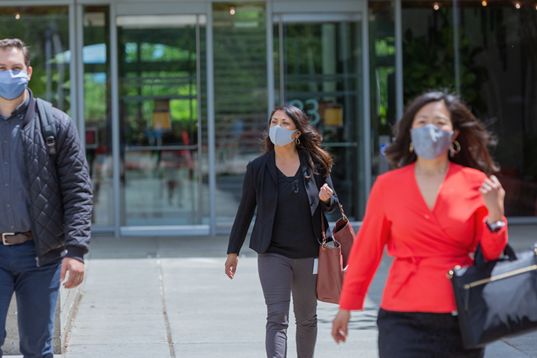- Exclusive research and expert insights reveal urgent trends in Philippines for leaders to address as the next phase of work unfolds.
- 84 percent of the Philippine workforce want flexible remote work options but 78 percent also crave face-to-face time with their teams
Philippines, April 13, 2021 – Microsoft Corp (NASDAQ: MSFT) (“Microsoft”) today announced the findings for Philippines from its first annual Work Trend Index. Titled “The Next Great Disruption is Hybrid Work – Are We Ready?” the report uncovers seven hybrid work trends every business leader needs to know as we enter this new era of work. The report indicates that business leaders in Philippines should resist the urge to see hybrid work as business as usual.
“The world is on the brink of a disruption as great as last year’s sudden shift to remote work: the move to hybrid — a blended model where some employees return to the workplace and others continue to work from home,” says Andres Ortola, Microsoft Philippines Country General Manager. “Adapting to this new hybrid model will require rethinking of long-held assumptions. The choices you make today will impact your organization for years to come. It’s a moment that requires clear vision and a growth mindset. These decisions will impact everything from how you shape culture, to how you attract and retain talent, to how you can better foster collaboration and innovation.”.
To help organizations through the transition, the 2021 Work Trend Index outlines findings from a study of more than 30,000 people in 31 countries, including the Philippines and analyzes trillions of aggregate productivity and labor signals across Microsoft 365 and LinkedIn. It also includes perspectives from experts who have studied collaboration, social capital, and space design at work for decades.
Seven hybrid work trends in the Philippines that every business leader needs to know:
One thing is abundantly clear: Microsoft is urging businesses to recognize that work is no longer bound to traditional notions of time and space when it comes to how, when, and where we work. Here are 7 emerging trends:
- Flexible work is here to stay: 84 percent of workers in the Philippines surveyed want flexible remote work options to continue, and 78 percent are craving more in-person time with their teams. Business leaders (71 percent) in the Philippines are recognizing the workplace evolution and are more likely planning to redesign office space for hybrid work.
- Leaders are out of touch with employees and need a wake-up call: Research shows that 23 percent of leaders in Philippines say they are thriving right now.
- High productivity is masking an exhausted workforce: 63 percent of workers in Philippines feel overworked and 31 percent feel exhausted.
- Gen Z is at risk and will need to be re-energized: More than two-thirds (70 percent) of this generation in Philippines — those between the ages of 18 and 25 — say they are merely surviving or flat-out struggling.
- Shrinking networks are endangering innovation: Aggregate trends across billions of Microsoft Teams meetings and Outlook emails show interactions with our broader networks diminished with the move to remote work. 52 percent of workers in the Philippines experienced decreased interactions with coworkers with the move to remote work.
- Authenticity will spur productivity and well-being: Coworkers leaned on each other in new ways to get through the last year. Through the rise of more personal interactions with colleagues, 53 percent of workers in Philippines now feel like they can be their full authentic selves at work this year.
- Talent is everywhere in a hybrid work world: 52 percent of those surveyed in the Philippines are planning to move to a new location this year, indicating that people no longer have to leave their desk, house or community to expand their career opportunities. This has also led to 42 percent of workers and 59 percent of Gen Zs in the Philippines likely to consider leaving their employers this year.
In addition to uncovering what’s at stake with the future of work, the Work Trend Index identifies five strategies for business leaders as they begin to make the necessary shift:
- Create a plan to empower people for extreme flexibility
- Invest in space and technology to bridge the physical and digital worlds
- Combat digital exhaustion from the top
- Prioritize rebuilding social capital and culture
- Rethink employee experience to compete for the best and most diverse talent
“During this pandemic we’ve observed a swift acceleration of certain pre-COVID trends. But perhaps one of the most exciting trends is this rise in remote work. As opportunity is democratized with remote work and talent movement, we’ll see a spread of skills across the country and this is the time for business leaders to take the opportunity to access to different skills and talent not previously available to them.” – Karin Kimbrough, Chief Economist, LinkedIn
To view the full findings, visit Microsoft’s Worklab, a digital publication about the future of work.
About WorkLab
WorkLab is a Microsoft digital publication devoted to illuminating the future of work, grounded in research and the lessons of the COVID-19 pandemic. By bringing together science-based insight and thoughtful, compelling stories on how work is changing, WorkLab’s mission is to start larger conversations about the future of work and help customers in the process.
About Microsoft
Microsoft (Nasdaq “MSFT” @microsoft) enables digital transformation for the era of an intelligent cloud and an intelligent edge. Its mission is to empower every person and every organization on the planet to achieve more.
For more information, please contact:
| Microsoft Asia
Simran Singh Sethi |
Edelman (Partnering agency for Microsoft Asia)
Natasha Vijaya |
Note to editors: For more information, news and perspectives from Microsoft, please visit the Microsoft News Center at http://news.microsoft.com. Web links, telephone numbers and titles were correct at time of publication, but may have changed. For additional assistance, journalists and analysts may contact Microsoft’s Rapid Response Team or other appropriate contacts listed at https://news.microsoft.com/microsoft-public-relations-contacts.

